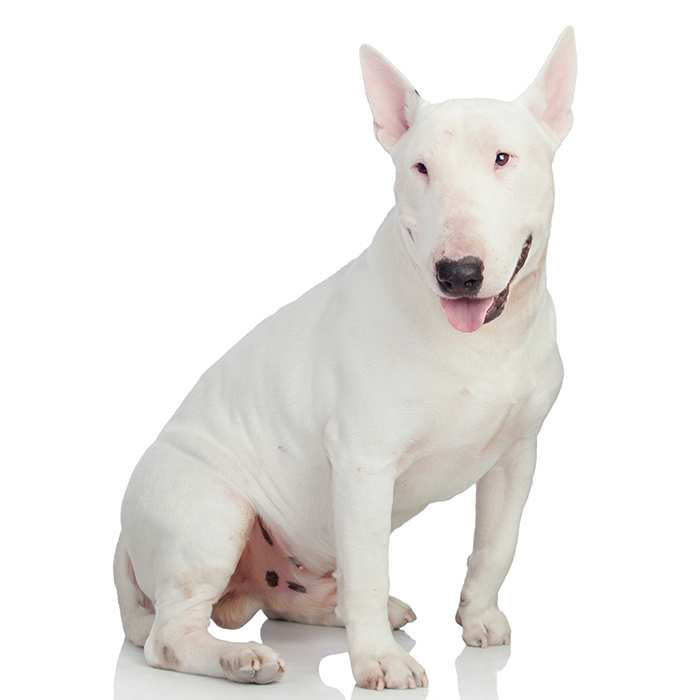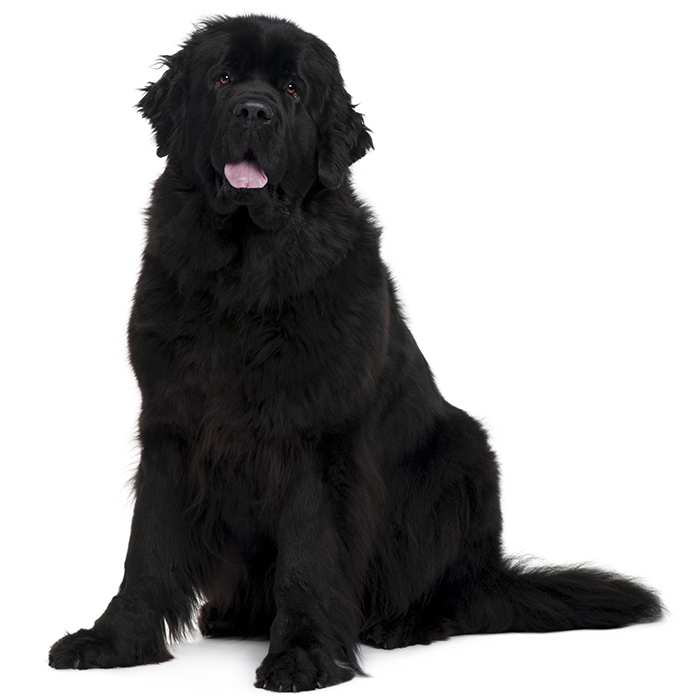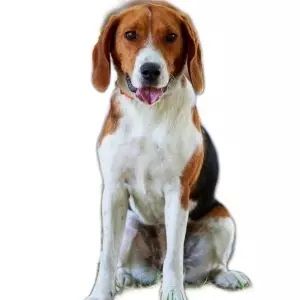Rhodesian Ridgeback


| Recommended for | Families with older children |
| Breed Classification | Hound |
| Other names | Lion dog |
| Lifespan | 10-12 years |
| Size | Large |
| Temperament | Affectionate, independent, even-tempered |
| Intelligence | Above average |
| Tendency to bark | Low |
| Maintenance Level | Medium – high |
| Health Risk | This breed has a higher than average probability of developing health issues during its lifetime, hence the cost to insure is above average. |
Insuring a Rhodesian Ridgeback?
Get our award-winning Nose-to-Tail Cover with up to $30k annual benefit limit, up to 90% of eligible vet bills back, and no sub-limits.
Get a quick quote
Is this breed right for you?
Try our breed selector quiz to find out your best matching breed!
Insuring a Rhodesian Ridgeback?
Get our award-winning Nose-to-Tail Cover with up to $30k annual benefit limit, up to 90% of eligible vet bills back, and no sub-limits.
Get a quick quote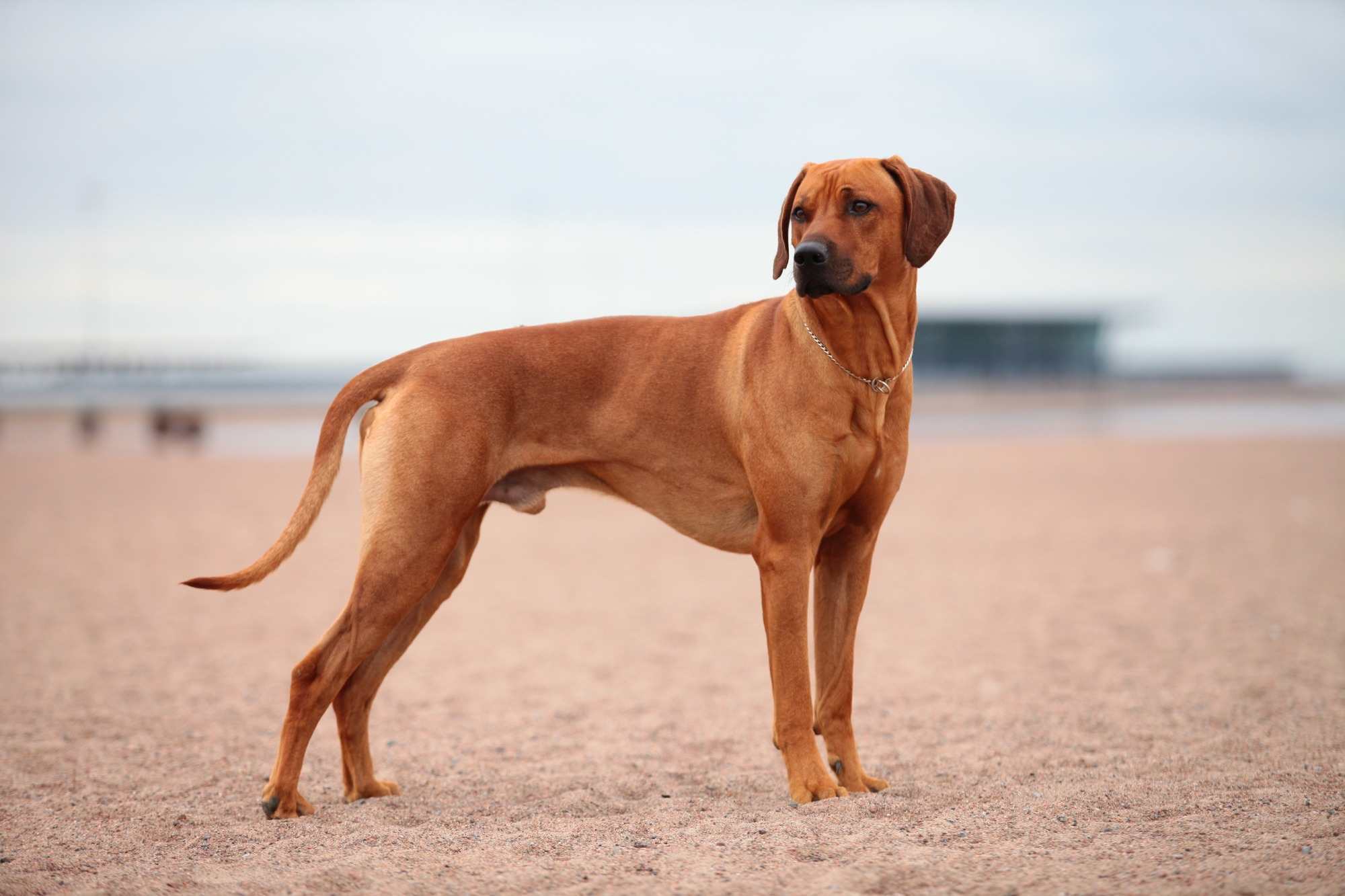
Breed history of Rhodesian Ridgebacks
The Rhodesian Ridgeback originated in Southern Africa in the mid 17th century. In order to produce a guarding and hunting dog ideally suited to local conditions, early European settlers crossed their imported sporting breeds with the small, semi-domesticated hunting dogs of the local people, who were known as the Hottentots. The Hottentot hunting dog had a ridge of hair along its spine running in a reverse direction to the rest of the coat and this characteristic became a defining feature of the lineage that followed.
Rhodesian Ridgebacks were originally used for hunting and later to protect park rangers from danger by alerting them of nearby lions. The breed, also called the Lion dog, became famous in its native Africa for its skill at tracking game, especially lion, in groups of two or three, and then, with great agility, keeping it at bay until the arrival of the hunter.
The Rhodesian Ridgeback is presently the only registered breed indigenous to Southern Africa. The original standard, which was drafted in 1922 by F.R. Barnes in Bulawayo, Rhodesia, was based on that of the Dalmatian and approved by the South African Kennel Union in 1926.
Today the Rhodesian Ridgeback is still used to hunt game in many parts of the world, but is especially prized as a watch-dog and family pet.
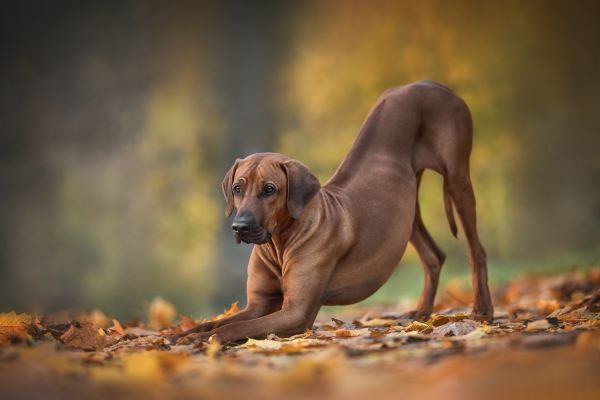
Physical description of Rhodesian Ridgebacks
Rhodesian Ridgebacks are tall and muscular, with a broad, flat head and triangular ears. They have deep chests, a black or brown nose, and occasionally a black tongue. Their front legs are muscular and straight, and they have quite a long tail which tapers to a point and curves slightly.
They have a short, sleek, dense coat which ranges from light wheaten to red wheaten in colour.
The breed’s most distinctive feature is the ridge or strip of hair growing in the opposite direction on its back, giving it the name “Ridgeback”.
| Weight range | Males 36 to 41 kg; females 32 kg |
| Height range | Males 63 to 69 cm; females 61 to 66 cm |
| Colours | Shades of wheaten |
| Coat length | Short |
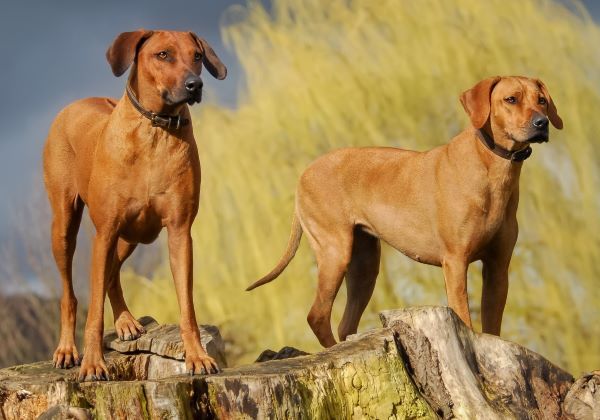
Rhodesian Ridgeback personality and temperament
Despite being ferocious hunters, Rhodesian Ridgebacks are calm, gentle and loving at home. They are whole-heartedly attached to their owner. They want to be wherever you are and they love you deeply, with unswerving dedication and loyalty.
Ridgebacks are devoted companions who are always ready to participate in your chosen activity, whether a run, hike or just lazing around. They need to live indoors with their human family. However, they do tend to bond with one person in the household and only acknowledge the other members.
Smart, brave and alert, they can be strong willed, determined, independent and extremely obstinate. They are not recommended for novice owners or those who do not have enough time or are not willing to put in the effort with their dog. An inactive Rhodesian Ridgeback dog can become destructive or develop behavioural problems, so regular and extensive physical activity and mental stimulation are needed to keep it occupied.
Always watchful, they can sense danger like no other hound and are very protective – and sometimes overprotective – of their family. They are excellent guard dogs and their sheer size along with their deep sounding bark will deter most intruders.
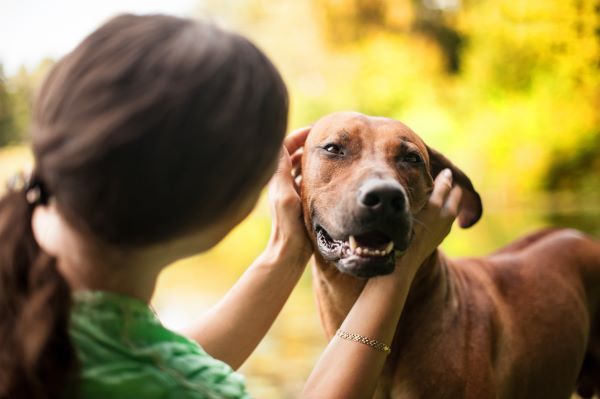
Rhodesian Ridgebacks with kids and other pets
The Rhodesian Ridgeback is placid, easygoing and quite tolerant of children, but they often play rough and can knock small children down. Supervision is advised of both the dog and child, especially kids under 5 years old. Children should be taught to treat dogs with respect, and definitely no teasing or tormenting.
Ridgebacks are good with other dogs, provided they are socialised and introduced correctly and with care. They can also be good with cats if brought up with them.
It is very important to socialise your Rhodesian Ridgeback puppy with other people, dogs and other pets to prevent the dog from being too reserved, or from having temperament issues with other animals in the future.
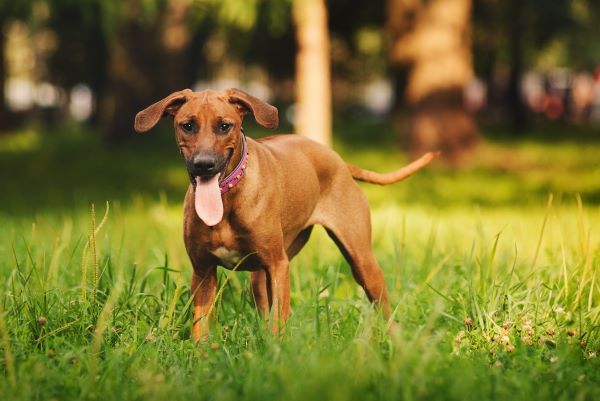
Rhodesian Ridgeback training and exercise
Rhodesian Ridgebacks are strong, athletic dogs who require a fair amount of exercise, including daily outings such as long walks as well as play sessions with their owner. They love to run, and they need physical activity to help keep them healthy and happy.
The breed can also get physical and mental exercise by participating in dog sports like tracking, agility, and other activities that dog and owner can enjoy together. Because of their very strong prey drive, Rhodesian Ridgebacks should always be in a safely enclosed area when off leash.
Training your Ridgeback can be challenging. They are an intelligent breed and will learn quickly, but like many other hounds they may become bored. They are independent thinkers. can be strong-willed, and are sometimes domineering. Therefore, they must be guided with a firm but a fair hand, patience, consistency and lots of positive reinforcement, from puppyhood and throughout adulthood.
| Energy level | High |
| Exercise requirements | High |
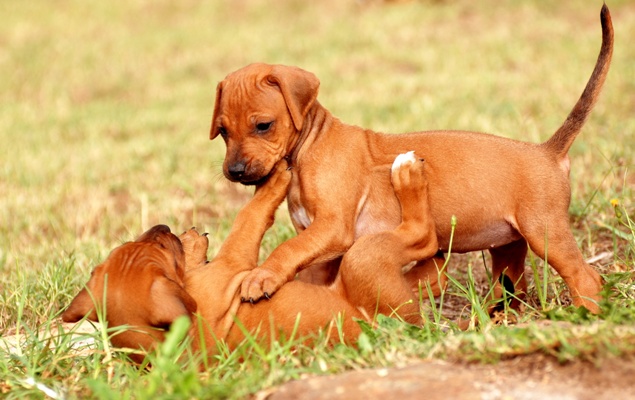
Rhodesian Ridgeback feeding and nutrition
The Rhodesian Ridgeback should be fed a premium, high-quality dog food appropriate to the dog’s age (puppy, adult, or senior), size and activity level. To aid a healthy growth and prevent problems in later years, puppies require a specially formulated diet, with higher protein, fat, calcium, and other vitamins and minerals.
Ridgebacks are sometimes referred to as the “world’s hungriest dog”, however, they do not require vast amounts of food. The amount they should eat greatly varies with age, the amount of exercise and their environment.
They are notorious ‘counter surfers,’ so be sure not to leave human food unattended. Ridgebacks that aren’t sufficiently exercised or overfed may become overweight, so watch your dog’s calorie consumption and weight level and don’t overindulge in the treats department.
Check with your vet if you have any concerns about your Rhodesian Ridgeback’s weight or diet.
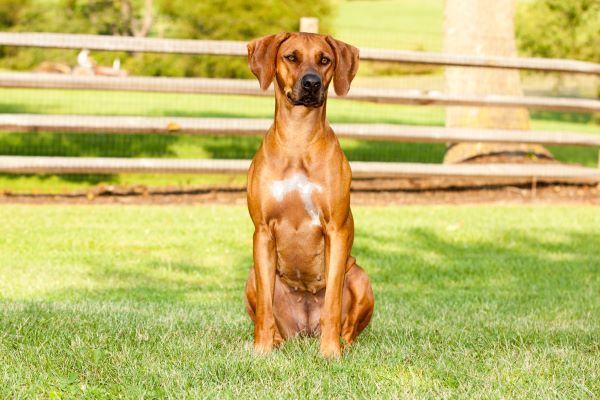
Rhodesian Ridgeback care and grooming
The Rhodesian Ridgeback is an average shedder and its smooth, short coat is very easy to groom. A regular, weekly brushing will help to remove loose hair and keep the coat glossy and shiny by distributing the natural oils through the coat. A bath about once a month (unless very dirty in between) also keeps your dog’s coat healthy.
Check the Ridgeback’s ears regularly to ensure they are clean and have no discharge, and clip their nails when required, being careful not to cut the quick.
Health issues for Rhodesian Ridgebacks
- Hip dysplasia occurs when the thigh bone and the hip joint do not fit together properly. This can cause pain or lameness in the dog and possibly arthritis later in life. Many dogs live relatively normal lives with the condition.
- Elbow dysplasia is common in large dog breeds and is believed to be caused by varying growth rates in the dog’s elbow. This leads to joint laxity, pain, and lameness. Surgery is available, but medication and weight loss may be prescribed by a vet to help control the pain.
- Dermoid Sinus is a skin condition in which a tube-shaped, cyst-like growth appears in the spinal area. It can protrude from the skin and possibly enter into the muscle tissue. If it becomes infected, the condition can become more serious. Some affected dogs have corrective surgery while some are euthanized.

- Degenerative myelopathy mainly affects German Shepherds but around 0.75% of Rhodesian Ridgebacks may be affected by this neurological disease which can cause parapesis. Signs include dragging the feet, slipping rear limbs, and eventually losing the ability to walk or stand by itself. There is a DNA test available to test for the gene, though affected dogs should not be bred.
- Gastric Dilatation-Volvulus, also known as bloat, is a deadly condition affecting large dogs such as the Rhodesian Ridgeback. Risk is increased if the dog is fed one large meal a day, eats quickly, drinks large amounts of water or exercises after eating. The stomach twists, making the dog unable to belch or vomit to get rid of excess air, and as a result the blood supply to the heart is impaired. Unless immediately attended to, the dog may die. Symptoms of bloat include a distended belly, excessive drooling, dry having, restlessness, exhaustion, weakness and a quick heart rate.
- Hypothyroidism, in which the thyroid gland does not produce enough thyroid hormone, is a growing issue among Rhodesian Ridgebacks. Symptoms include weight gain and hair loss. Epilepsy can also be caused by hypothyroidism. Affected dogs can take daily oral medication to combat the condition.
- Mast cell tumours make up about 20% of tumours in dogs. They are characterised by small, allergy-like lumps which the dog may scratch at or bite. If the tumour is caught and treated early, the prognosis is generally very good.
Not all conditions are covered by Pet Insurance. For details of Bow Wow Meow Pet Insurance cover, refer to the Product Disclosure Statement.
What do Rhodesian Ridgeback owners claim for the most?
- Mass Lesion
- Otitis Externa
- Skin Allergy
- Wound
- Dermatitis
Thinking about insuring a Rhodesian Ridgeback
Thinking about insuring a Rhodesian Ridgeback
Learn moreThinking about insuring a Rhodesian Ridgeback
Learn moreFree engraved pet ID tag on sign up3
Customer Satisfaction
21 day cooling off
Easy to use Pet Portal

GapOnly® in vet claims
MORE INFORMATION
Rhodesian Ridgeback Club Inc: http://www.therhodesianridgebackclubinc.com/
National Rhodesian Ridgeback Council: https://www.nrrcaustralia.org/
Rhodesian Ridgeback Club of Victoria: https://www.rrcv.org/
Rhodesian Ridgeback Club of WA: http://rrcwa.com.au/
Rhodesian Ridgeback Club of SA: http://www.rrclubsa.com/

